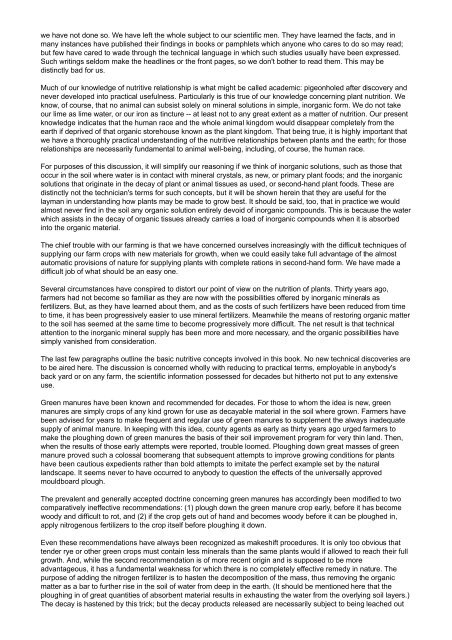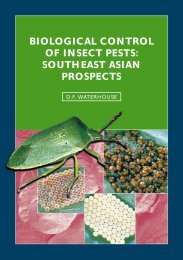Ploughman's Folly Ploughman's Folly - EcoPort
Ploughman's Folly Ploughman's Folly - EcoPort
Ploughman's Folly Ploughman's Folly - EcoPort
Create successful ePaper yourself
Turn your PDF publications into a flip-book with our unique Google optimized e-Paper software.
we have not done so. We have left the whole subject to our scientific men. They have learned the facts, and in<br />
many instances have published their findings in books or pamphlets which anyone who cares to do so may read;<br />
but few have cared to wade through the technical language in which such studies usually have been expressed.<br />
Such writings seldom make the headlines or the front pages, so we don't bother to read them. This may be<br />
distinctly bad for us.<br />
Much of our knowledge of nutritive relationship is what might be called academic: pigeonholed after discovery and<br />
never developed into practical usefulness. Particularly is this true of our knowledge concerning plant nutrition. We<br />
know, of course, that no animal can subsist solely on mineral solutions in simple, inorganic form. We do not take<br />
our lime as lime water, or our iron as tincture -- at least not to any great extent as a matter of nutrition. Our present<br />
knowledge indicates that the human race and the whole animal kingdom would disappear completely from the<br />
earth if deprived of that organic storehouse known as the plant kingdom. That being true, it is highly important that<br />
we have a thoroughly practical understanding of the nutritive relationships between plants and the earth; for those<br />
relationships are necessarily fundamental to animal well-being, including, of course, the human race.<br />
For purposes of this discussion, it will simplify our reasoning if we think of inorganic solutions, such as those that<br />
occur in the soil where water is in contact with mineral crystals, as new, or primary plant foods; and the inorganic<br />
solutions that originate in the decay of plant or animal tissues as used, or second-hand plant foods. These are<br />
distinctly not the technician's terms for such concepts, but it will be shown herein that they are useful for the<br />
layman in understanding how plants may be made to grow best. It should be said, too, that in practice we would<br />
almost never find in the soil any organic solution entirely devoid of inorganic compounds. This is because the water<br />
which assists in the decay of organic tissues already carries a load of inorganic compounds when it is absorbed<br />
into the organic material.<br />
The chief trouble with our farming is that we have concerned ourselves increasingly with the difficult techniques of<br />
supplying our farm crops with new materials for growth, when we could easily take full advantage of the almost<br />
automatic provisions of nature for supplying plants with complete rations in second-hand form. We have made a<br />
difficult job of what should be an easy one.<br />
Several circumstances have conspired to distort our point of view on the nutrition of plants. Thirty years ago,<br />
farmers had not become so familiar as they are now with the possibilities offered by inorganic minerals as<br />
fertilizers. But, as they have learned about them, and as the costs of such fertilizers have been reduced from time<br />
to time, it has been progressively easier to use mineral fertilizers. Meanwhile the means of restoring organic matter<br />
to the soil has seemed at the same time to become progressively more difficult. The net result is that technical<br />
attention to the inorganic mineral supply has been more and more necessary, and the organic possibilities have<br />
simply vanished from consideration.<br />
The last few paragraphs outline the basic nutritive concepts involved in this book. No new technical discoveries are<br />
to be aired here. The discussion is concerned wholly with reducing to practical terms, employable in anybody's<br />
back yard or on any farm, the scientific information possessed for decades but hitherto not put to any extensive<br />
use.<br />
Green manures have been known and recommended for decades. For those to whom the idea is new, green<br />
manures are simply crops of any kind grown for use as decayable material in the soil where grown. Farmers have<br />
been advised for years to make frequent and regular use of green manures to supplement the always inadequate<br />
supply of animal manure. In keeping with this idea, county agents as early as thirty years ago urged farmers to<br />
make the ploughing down of green manures the basis of their soil improvement program for very thin land. Then,<br />
when the results of those early attempts were reported, trouble loomed. Ploughing down great masses of green<br />
manure proved such a colossal boomerang that subsequent attempts to improve growing conditions for plants<br />
have been cautious expedients rather than bold attempts to imitate the perfect example set by the natural<br />
landscape. It seems never to have occurred to anybody to question the effects of the universally approved<br />
mouldboard plough.<br />
The prevalent and generally accepted doctrine concerning green manures has accordingly been modified to two<br />
comparatively ineffective recommendations: (1) plough down the green manure crop early, before it has become<br />
woody and difficult to rot, and (2) if the crop gets out of hand and becomes woody before it can be ploughed in,<br />
apply nitrogenous fertilizers to the crop itself before ploughing it down.<br />
Even these recommendations have always been recognized as makeshift procedures. It is only too obvious that<br />
tender rye or other green crops must contain less minerals than the same plants would if allowed to reach their full<br />
growth. And, while the second recommendation is of more recent origin and is supposed to be more<br />
advantageous, it has a fundamental weakness for which there is no completely effective remedy in nature. The<br />
purpose of adding the nitrogen fertilizer is to hasten the decomposition of the mass, thus removing the organic<br />
matter as a bar to further rise in the soil of water from deep in the earth. (It should be mentioned here that the<br />
ploughing in of great quantities of absorbent material results in exhausting the water from the overlying soil layers.)<br />
The decay is hastened by this trick; but the decay products released are necessarily subject to being leached out






